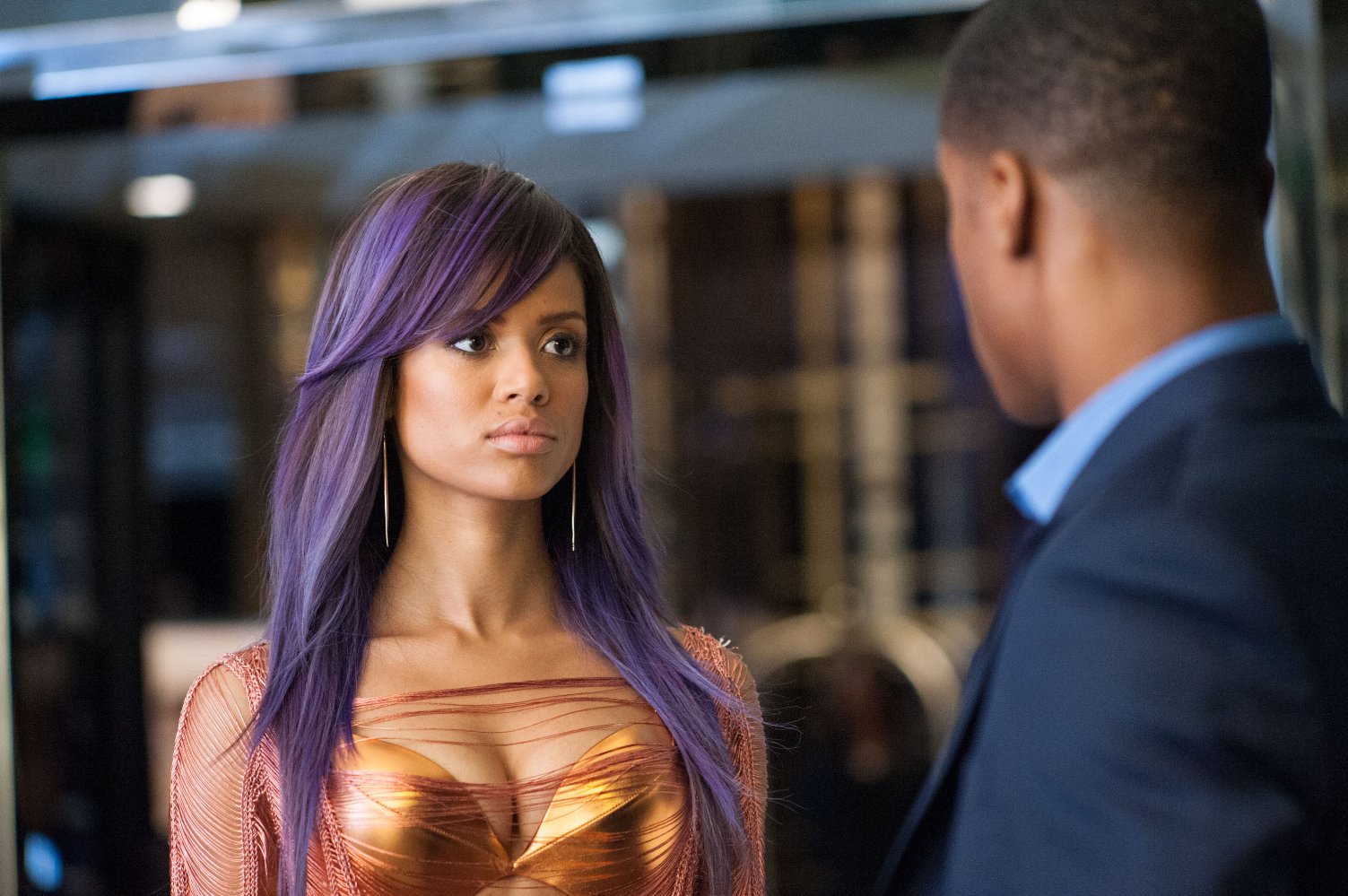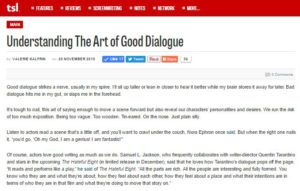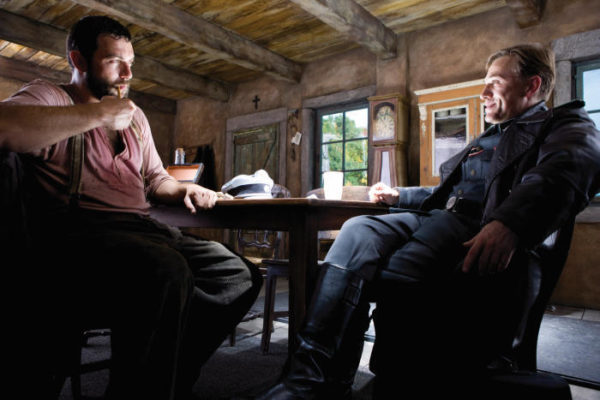By Valerie Kalfrin
The Script Lab, Nov. 20, 2015
Good dialogue strikes a nerve, usually in my spine. I’ll sit up taller or lean in closer to hear it better while my brain stores it away for later. Bad dialogue hits me in my gut, or slaps me in the forehead.
It’s tough to nail, this art of saying enough to move a scene forward but also reveal our characters’ personalities and desires. We run the risk of too much exposition. Being too vague. Too wooden. Tin-eared. On the nose. Just plain silly.
Listen to actors read a scene that’s a little off, and you’ll want to crawl under the couch, Nora Ephron once said. But when the right one nails it, “you’d go, ‘Oh my God, I am a genius! I am fantastic!’”
Of course, actors love good writing as much as we do. Samuel L. Jackson, who frequently collaborates with writer-director Quentin Tarantino and stars in the upcoming The Hateful Eight (in limited release in December), said that he loves how Tarantino’s dialogue pops off the page. “It reads and performs like a play,” he said of The Hateful Eight. “All the parts are rich. All the people are interesting and fully formed. You know who they are and what they’re about, how they feel about each other, how they feel about a place and what their intentions are in terms of who they are in that film and what they’re doing to move that story on.”
With that in mind, we thought we’d look to other wordsmiths for clues on how to craft our own memorable dialogue.
1. Find the rhythm
Aaron Sorkin, who wrote the screenplay for Steve Jobs (out in theaters) and Tarantino have distinct writing styles. So do Diablo Cody (Juno, Ricki and the Flash) and Carrie Fisher, best known onscreen as Princess Leia but a script doctor on such films as Hook, Sister Act, and The Wedding Singer.
Yet even when their characters are pitched at the same garrulous or biting level, they all have rhythm.
“I like it,” Tarantino once said. “I think that in my dialogue there’s a bit of whatever you would call it, a music or poetry, and the repetition of certain words helps give it a beat or a rhythm. It just happens and I just go with it, looking for the rhythm of the scene.”
Ideally, each major character in a script should have a voice – or rhythm – that’s his or her own.
Writing coach Rick Horowitz says columnists can shape and change their voices through word choices, pace, structure, even punctuation. That advice also applies to screenwriters.
You can write 30 words that are turgid and 500 words that will have you hanging on every one, Horowitz says. String together clauses that tumble over another, and you’ll create a smooth, complex, legato rhythm. Use short bursts for a quick staccato. “I can give you 10 words that move like this,” he notes. “An alternative approach abides by identical restrictions, yet resonates differently.”
2. Create touchstones
Develop reference points for your characters, and their voices become clear – to the actors as well as the audience. Harrison Ford (pardon another Star Wars reference) told Entertainment Weekly that the 1977 original worked so well because of the characters’ interplay: “There was a callow youth, a beautiful princess, a wise old warrior, and there was a smart-ass.”
A touchstone can be whatever works for you. William Goldman (Butch Cassidy and the Sundance Kid, All the President’s Men) casts a film in his head to imagine how certain scenes and lines might play. ScreenwritingU.com suggests keeping three descriptive words for each character in mind while writing. Gina Prince-Bythewood explains that the Nina Simone song “Blackbird” guided her in writing 2014’s Beyond the Lights, particularly her protagonist, Noni (Gugu Mbatha-Raw). “[I]t really influenced the writing of it and the character, and the desire for this character Noni to want to emulate that truth and depth, but also to have a girl who has a very strained sense of identity.”
Even if you have only a handful of voices in your toolbox, you can use and refine them as Joss Whedon does, said Charlie Jane Anders, writing at iO9, “There’s always the stilted British person (Giles/Wesley/Adelle), the funny, quippy nerd (Xander/Topher/etc.) and the lost/crazy girl (River/Echo/Fred/etc.). And the amazing thing is — those characters are all wildly individual and have tons of depth.”
I can imagine Whedon referring to these thumbnail descriptions from 2012’s The Avengers: “Let’s do a head count here: Your brother, the demigod; a super soldier, a living legend who kind of lives up to the legend; a man with breathtaking anger-management issues; a couple of master assassins…”
All voiced by Tony Stark (Robert Downey Jr.), aka Iron Man, who describes himself as follows: “Genius, billionaire, playboy, philanthropist.”
3. Skip the small talk – unless there’s subtext
Alfred Hitchcock said that drama is like real life without the dull bits. Goldman starts scenes as late as possible, then leaves early: “You don’t want to begin with ‘Once upon a time,’ because the audience gets antsy.” Even Sorkin’s talky script for The Social Network bypasses the boring by starting in the middle of a conversation. “The worst crime you can commit with an audience is telling them something they already know. We were always running ahead.”
In real life, we can’t escape small talk, but onscreen, it works best with subtext. Tarantino’s Inglourious Basterds has several scenes rich in subtext, starting with SS colonel Hans Landa (Christoph Waltz) leisurely interrogating a farmer while a Jewish family hides beneath the floorboards. I love the restaurant scene where Landa later meets the family’s sole survivor (Mélanie Laurent), now a cinema owner in Paris, to assess whether to allow a private screening for Hitler at her theater. The tension mounts as we wonder whether he’ll discover her identity between bites of pastry and cream.
Likewise, “Breaking Bad” writer Gennifer Hutchison magnified the strain among drug kingpin Walter White (Bryan Cranston), his wife, Skylar (Anna Gunn), and two dinner guests in the fifth-season episode “Confessions” by having the waiter at a taqueria pop in to discuss drinks and specials at the most-awkward moments.
4. Build on rhetoric
If your character has a monologue or soliloquy, rhetorical devices can add punch. Stephen Marche of Esquire parsed out the similar rhetorical structure and techniques in Liam Neeson’s 2008 Taken speech and famous historical speeches like Winston Churchill’s “We Shall Fight on the Beaches” and Dr. Martin Luther King, Jr.’s “I Have a Dream.” All repeat particular phrases (“I will,” “We shall,” “I have a dream”) in the future tense, and use simple words to combine abstract ideas (“a particular set of skills”) with concrete details (“I will find you and I will kill you”).
Writer-director Joon Ho Bong, adapting the dystopian comic Snowpiercer for the 2013 film, crafted two rhetorically strong monologues. In one, Curtis (Chris Evans) reveals his character’s torment and a dark secret about life aboard the train circling a long-frozen Earth. In another, Mason (Tilda Swinton) outlines the order of life among the passengers: “A shoe belongs on your foot. A hat belongs on your head. I am a hat. You are a shoe. … When the foot seeks the place of the head, the sacred line is crossed. Know your place. Keep your place. Be a shoe.”
The book Word Hero by Jay Heinrichs is a detailed but fun primer about various rhetorical techniques (Heinrich calls them “witcraft”) that elevate quotes and help words stick.
5. Eavesdrop
Ephron thought one of the best preparations for her screenwriting career was an earlier gig in journalism. It was “truly a way of getting out of whatever narrow world we all grow up in,” she said. We all draw on our backgrounds and experiences when writing (one reason why diversity is important), so to develop an ear for how real people talk among different walks of life, writers from various disciplines advocate eavesdropping. Diablo Cody writes a scene with it in 2011’s Young Adult where author Mavis (Charlize Theron) listens in on two teenage girls gossiping about the chemistry one has with the crush she’s texting, then types the girl’s phrase “textual chemistry” right into her manuscript.
A diner or coffee shop tends to be a good spot, provided the clientele has the voices you need. (If you want to know how college students talk, you’ll want a university hangout, not the Starbucks in suburbia.) If you live in a large city, you can eavesdrop without trying just by riding public transit. I remember lots of lines I overheard on the New York City subway, like the time a woman assured her guy friend that she was done with her ex taking up space in her head. “He’s renting whole condominiums in your head,” her pal replied.
6. Respect the silence
If you’re having trouble with a patch of dialogue, you might not need it. Writer-directors like Alexander Payne relish the tiny moments in relationships, so in 2011’s The Descendants (adapted with Nat Faxon and Jim Rash from the novel by Kaui Hart Hemmings), a new beginning is as simple as sharing a quilt and ice cream in front of the TV.
Prince-Bythewood, who also directs, said she noticed in both 2000’s Love & Basketball and Beyond the Lights how dialogue becomes unnecessary when the characters enjoy each other’s silence. “We get everything we need to know in that moment,” she describes. “It’s just so much more interesting to show rather than tell.”
From http://thescriptlab.com/features/main/3432-understanding-the-art-of-good-dialogue



